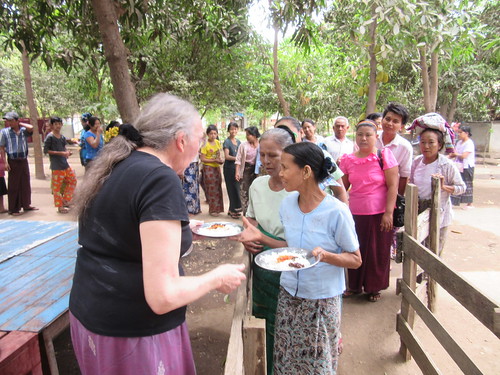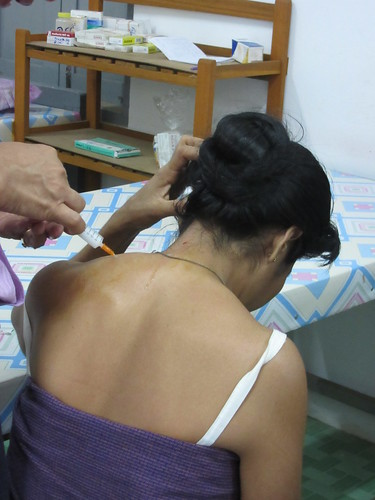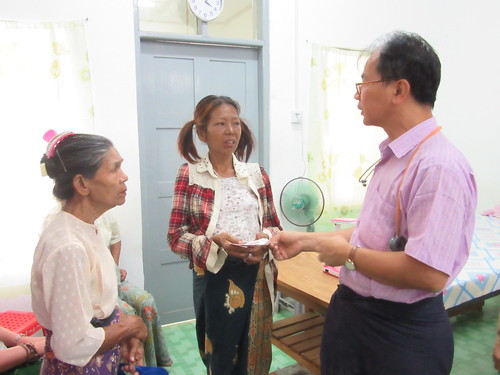In Part 1, I briefly described the Clinic and the activities on Friday 24th April 2015.
In Part 2, I described what I saw on Saturday 25th April 2015.
It might be worth pointing out some of the differences between Burmese and Western cultures. Some readers will be surprised that I have been able to publish pictures of patients receiving treatment. What about patient confidentiality? What about personal privacy? I was appalled myself at first, but these concepts don't seem to exist as Westerners might understand them in Myanmar (and, indeed, many other countries). Secondly, when charitable donations are made, they are frequently recorded in photographs. Even if photographs are not made, contributions may be otherwise recorded. For instance, many pagodas display a list of recent donations and buildings which have been donated frequently carry marble tablets naming the donor.
Sunday 26th April 2015
Once again, Emily and I were picked up around 08:00 by car and taken to the Clinic. On arrival, we discovered that, despite Dr. Hla Tun and his staff working until 02:10 on Sunday morning, 28 patients from his Saturday list had been 'held over' and he started seeing them at about 09:00. In addition, about 200 more patients had registered. Since Sunday is the last day of the 3-day clinic opening each week, it's not possible to 'carry over' untreated patients and so the Doctor may 'close' his list earlier on Sunday to ensure that everyone is seen.
The newly-qualified doctors mentioned in Part 2 once again practiced their diagnostic skills on Sunday.
 The 'group shot'.
The 'group shot'.
The cases which Dr. Hla Tun deals with frequently involve various simultaneous problems. Poverty often leads to poor diet and the body's immune system becomes weakened and less able to deal with diseases. Mobility problems are widespread and joint pains can prevent people from working and earning a living. As appropriate, different strategies are used by Doctor Hla Tun but aspirating fluid from joints followed by various injections for pain relief and to improve the body's immunity is a common approach. Sometimes dietary supplements in powder form are provided for the patient to take. In more serious cases, an infusion of amino acids may be made at the clinic. The rigours of travelling long distances in Myanmar to reach the Bagan Clinic may add to the problems.
 A patient receiving an intra-muscular injection.
A patient receiving an intra-muscular injection.
Lunch
The physical well-being of waiting patients is taken very seriously and there are various dormitories which can be used by waiting patients plus toilets with washing facilities. On each clinic day, a hot lunch is provided for waiting patients and accompanying relatives at around 11:30. During the morning, a number of monastery people had been involved in the preparation of those meals.

The Head Monk overseeing vegetable preparation for the patient lunches.
At about 11:30 a queue of waiting patients formed and, as usual, the Head Monk started the distribution himself but, on Sunday, he then invited me to take over and, within a few minutes, around 220 meals had been distributed. The business of making an offering has great cultural significance in Myanmar, with its Buddhist traditions. On some clinic days, an evening meal is provided as well.
 Distribution of hot lunches.
Distribution of hot lunches.
After the patient lunches, the Doctor continued consultations until about 13:30, then there was a break, allowing some of the medical staff to take lunch in the monastery, as on previous days.
Additional Tests
From time to time during the day, Dr. Hla Tun referred patients to the laboratory for specific tests on blood/urine or for E.C.G. tests. Remarkably quickly, patients would return, clutching the completed results sheet or the E.C.G. plot. The benefits of these in-house facilities are enormous, in facilitating timely confirmation of a diagnosis. It is not practical to recall patients, many of whom have travelled long distances to the clinic, so treatment must be completed in a single visit.
 The laboratory technician and well-equipped laboratory.
The laboratory technician and well-equipped laboratory.
The Afternoon Clinic
The afternoon clinic continued in a similar manner with a lot of help given to improve mobility and various other problems.

A patient receives an injection.
A woman from Mandalay suffering from cirrhosis of the liver had been treated in the morning and given an infusion of amino acids. She had travelled with her mother by train from Mandalay (fairly cheap but not a journey to undertake lightly). She seemed little improved in the afternoon but the Bagan Clinic could not provide further treatment so the Doctor made a cash donation towards hospitalisation and transportation costs.
 Dr. Hla Tun giving a donation towards cost of hospitalisation.
Dr. Hla Tun giving a donation towards cost of hospitalisation.
I'm afraid I left the Doctor at 16:30 and returned to the comfort of my hotel - the Bagan Thiripyitsaya Sanctuary Resort.
Next?
The plan for the following day was to re-visit two schools in the Bagan area with Doctor Hla Tun. These schools are supported by the RTM Social Contribution. Later in the afternoon, we were due to fly back to Yangon.
Go to next post on this trip.
All my posts on the Bagan Medical Clinic can be found here.
All my posts describing this trip to Myanmar can be found here.
My pictures
The internet in the Bagan area seemed much improved, but was not suitable for uploading all my pictures. I finally made them available after my return to England. The following albums (on Flickr) are relevant to this post:-
Bagan Clinic, Sunday, 26th April 2015.
Bagan Thiripyitsaya Sanctuary Resort.
All my albums for this trip can be found here.
[Text amended, pictures added 11th June 2015]
